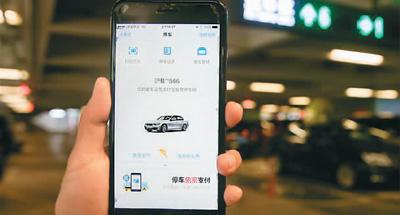More parking facilities planning
"Smart parking" makes the streets and lanes more smooth
In the parking lot of Terminal T2 of Shanghai Hongqiao Airport, a car owner showed the mobile APP page of "Smart Parking". Photo by Xinhua News Agency reporter Ding Ting
Sensorless parking, automatic parking, refined management...As one of the key contents of the "new infrastructure", smart parking has become the "new favorite" of the industry. In recent years, many places in China have continued to increase the planning and construction of smart parking facilities, and encouraged the development of automatic valet parking and smart parking lots. The smart parking market has rapidly risen.
Realize "Free Parking" in Hutong
Walking into Ganmian Hutong on the north side of Jinbao Street, Dongcheng District, Beijing, rows of cars are parked in berths along the road, and the real-time parking information displayed on the large screen of the Resident Autonomous Parking Management Office is clear at a glance. Thanks to the new smart management model of refined parking spaces, the "dead end" that used to be "less parking spaces, difficult parking, and random parking" is now clean and tidy, and the entire road section is unimpeded.
“The traditional parking management model in Ganmian Hutong amplifies the disadvantages of private parking spaces and disorderly parking, making parking management more complicated.” said Gao Xuan, director of Shougang Fund Micro-Parking (Beijing) Technology Co., Ltd. The micro-parking team received the project Later, the hutong vehicle parking requirements were sorted out, and an information management system for monitoring and monitoring parked vehicles was quickly established, which can intelligently collect vehicle parking data and realize real-time operation and control of parking spaces. In view of the situation that the certified vehicle is "not in the seat" and the foreign vehicle "occupying at will", the system will automatically send the corresponding vehicle information to the parking manager's handheld terminal in real time, and solve the chaos of the vehicle through the combination of scientific and technological monitoring and personnel control. The problem of parking.
Faced with many common ailments that plague urban parking, smart parking took advantage of the situation and opened up the "last mile" of urban parking. Gao Xuan said that smart parking management has now achieved obvious results. Residents will have parking spaces to park after returning home, and vehicle safety has also been guaranteed. "Parking freedom" has been realized in alleys.
Statistics from the "Market Outlook and Investment Strategic Planning Analysis Report of China's Smart Parking Industry" released by the Prospective Industry Research Institute show that the scale of the smart parking market will continue to increase at a rate of about 20% in the next few years, and it is expected to exceed 15 billion yuan within the year .
IoT powers automatic parking
In the parking lot, the vehicle can automatically find the parking space and park in the parking space. When picking up the car, it only needs to be called by one button to realize the automatic “pick up and drive”... With the popularity of the Internet of Things concept and 5G technology, such a scene reality.
Since the beginning of this year, Shandong, Shanxi, Chongqing, Wuhan and other places have focused on the development of smart cars and parking facilities, and have issued policies to encourage the development of automatic valet parking and smart parking lots construction and transformation experiments, and explored the establishment and improvement of related management systems and standards. In October last year, Bosch, the world's largest auto parts supplier, and GAC Research Institute reached a cooperation in the field of automatic valet parking technology, taking the lead in promoting automatic valet parking technology and smart parking lots.
On the technical path of realizing automatic valet parking, Bosch’s answer is “to use the cooperation of field-side smart devices and on-board sensors to achieve L4 level autonomous driving”. Simply put, it is to use high technology to make the parking lot more intelligent, which can automatically guide vehicles. The automatic valet parking system will complete tasks such as vehicle positioning and obstacle recognition through smart cameras arranged in the parking lot, and assign free parking spaces to the vehicles to plan the optimal path. At the same time, a communication network based on 5G technology can establish a real-time, stable, and reliable communication connection between parking lot infrastructure and vehicles, which is convenient for managers to deal with various situations related to car owners and vehicles at any time.
Industry insiders pointed out that through intelligent cloud interconnection, the operation mode of automatic valet parking can also realize more value-added services such as automatic charging of electric vehicles and shared vehicle handover, which will also encourage more parking lots and enterprises to take on the field side The construction cost accelerates the deployment of smart parking lots.
Smart parking has developed rapidly in the past year, but it has also encountered problems such as "separate governance" among different parking lots and facilities, and lack of systematic management.
In order to achieve the goal of “same platform” for smart parking operation and management, CSCEC’s R&D team launched the “CSCEC Smart Parking Cloud Platform” that integrates data analysis, cross-regional resource allocation and other functions, and took the lead in fully deploying and landing in Dongguan, Guangdong. Access to more than 2,000 parking lots in the city, with a total of more than 400 million cumulative parking data, and a peak parking data throughput of more than 5 million.
Experts believe that with the help of high-tech methods such as multi-dimensional big data analysis and visual display, smart parking has a lot of room for development in the future, which can effectively help urban management. Relevant departments can use the data of various regional parking lots and parking spaces to provide a basis for the management and operation of urban parking resources, as well as provide parking navigation guidance, non-inductive payment and other diversified services for car owners.
Jin Chen

